coolant temperature JEEP GRAND CHEROKEE 2014 WK2 / 4.G User Guide
[x] Cancel search | Manufacturer: JEEP, Model Year: 2014, Model line: GRAND CHEROKEE, Model: JEEP GRAND CHEROKEE 2014 WK2 / 4.GPages: 220, PDF Size: 6.12 MB
Page 142 of 220
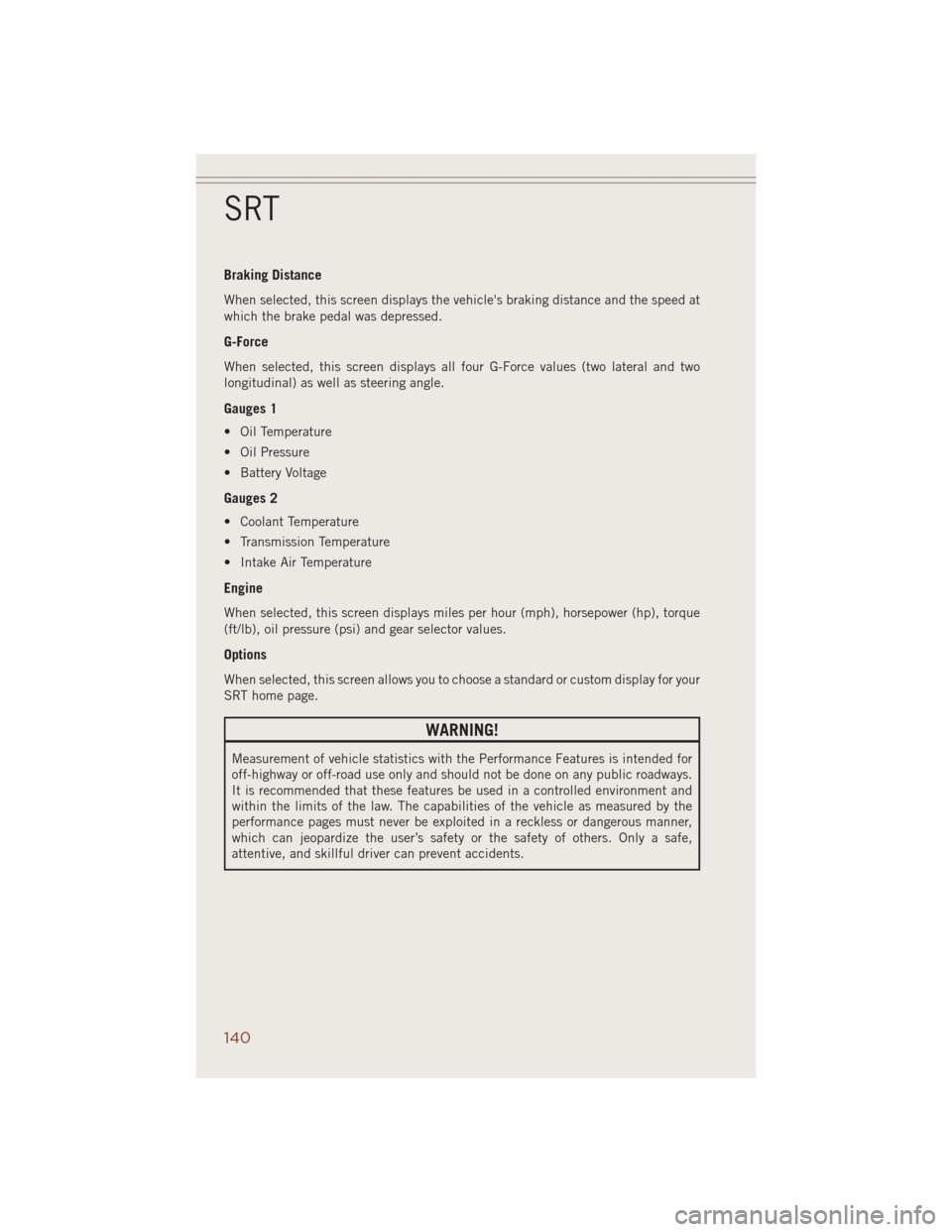
Braking Distance
When selected, this screen displays the vehicle's braking distance and the speed at
which the brake pedal was depressed.
G-Force
When selected, this screen displays all four G-Force values (two lateral and two
longitudinal) as well as steering angle.
Gauges 1
• Oil Temperature
• Oil Pressure
• Battery Voltage
Gauges 2
• Coolant Temperature
• Transmission Temperature
• Intake Air Temperature
Engine
When selected, this screen displays miles per hour (mph), horsepower (hp), torque
(ft/lb), oil pressure (psi) and gear selector values.
Options
When selected, this screen allows you to choose a standard or custom display for your
SRT home page.
WARNING!
Measurement of vehicle statistics with the Performance Features is intended for
off-highway or off-road use only and should not be done on any public roadways.
It is recommended that these features be used in a controlled environment and
within the limits of the law. The capabilities of the vehicle as measured by the
performance pages must never be exploited in a reckless or dangerous manner,
which can jeopardize the user’s safety or the safety of others. Only a safe,
attentive, and skillful driver can prevent accidents.
SRT
140
Page 144 of 220
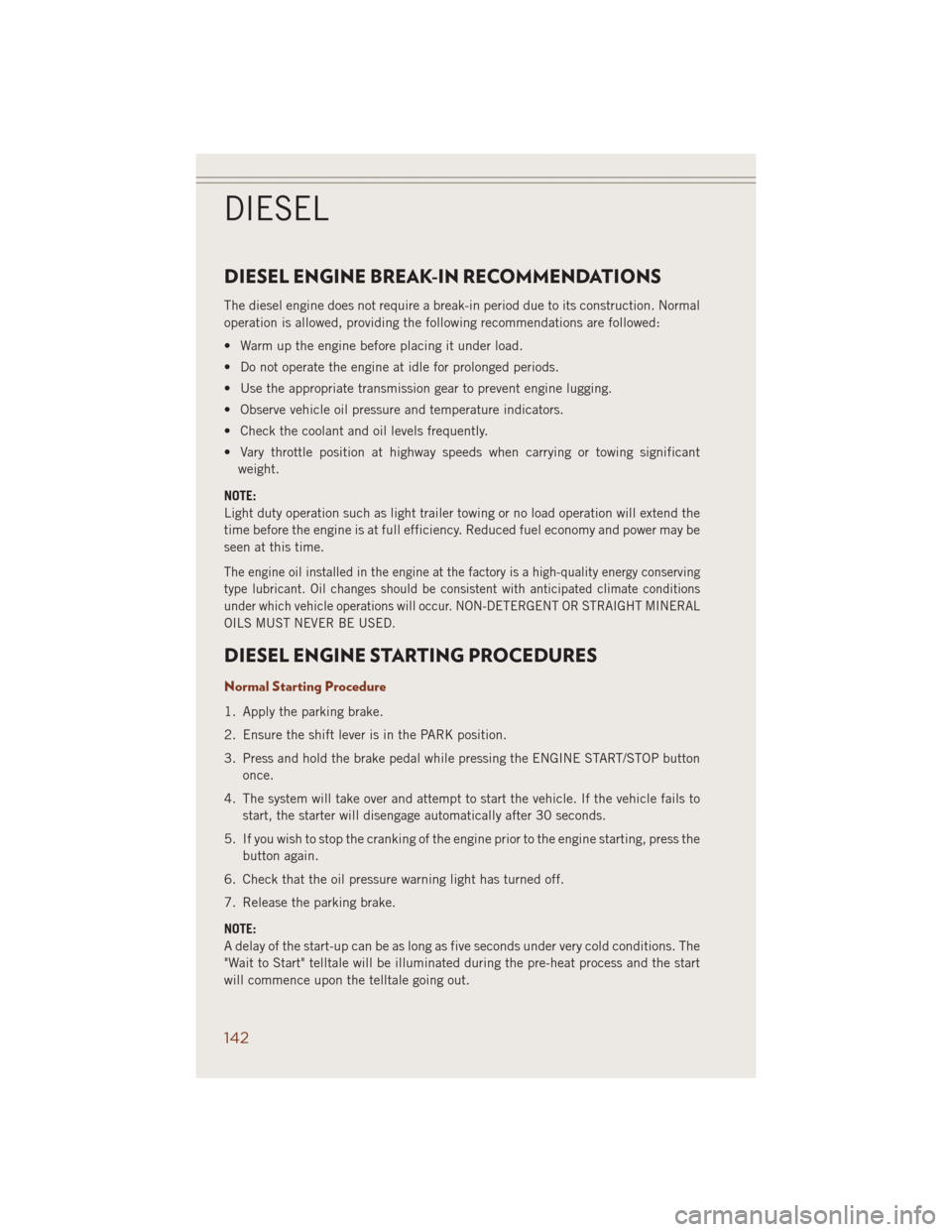
DIESEL ENGINE BREAK-IN RECOMMENDATIONS
The diesel engine does not require a break-in period due to its construction. Normal
operation is allowed, providing the following recommendations are followed:
• Warm up the engine before placing it under load.
• Do not operate the engine at idle for prolonged periods.
• Use the appropriate transmission gear to prevent engine lugging.
• Observe vehicle oil pressure and temperature indicators.
• Check the coolant and oil levels frequently.
• Vary throttle position at highway speeds when carrying or towing significant
weight.
NOTE:
Light duty operation such as light trailer towing or no load operation will extend the
time before the engine is at full efficiency. Reduced fuel economy and power may be
seen at this time.
The engine oil installed in the engine at the factory is a high-quality energy conserving
type lubricant. Oil changes should be consistent with anticipated climate conditions
under which vehicle operations will occur. NON-DETERGENT OR STRAIGHT MINERAL
OILS MUST NEVER BE USED.
DIESEL ENGINE STARTING PROCEDURES
Normal Starting Procedure
1. Apply the parking brake.
2. Ensure the shift lever is in the PARK position.
3. Press and hold the brake pedal while pressing the ENGINE START/STOP button
once.
4. The system will take over and attempt to start the vehicle. If the vehicle fails to
start, the starter will disengage automatically after 30 seconds.
5. If you wish to stop the cranking of the engine prior to the engine starting, press the
button again.
6. Check that the oil pressure warning light has turned off.
7. Release the parking brake.
NOTE:
A delay of the start-up can be as long as five seconds under very cold conditions. The
"Wait to Start" telltale will be illuminated during the pre-heat process and the start
will commence upon the telltale going out.
DIESEL
142
Page 158 of 220
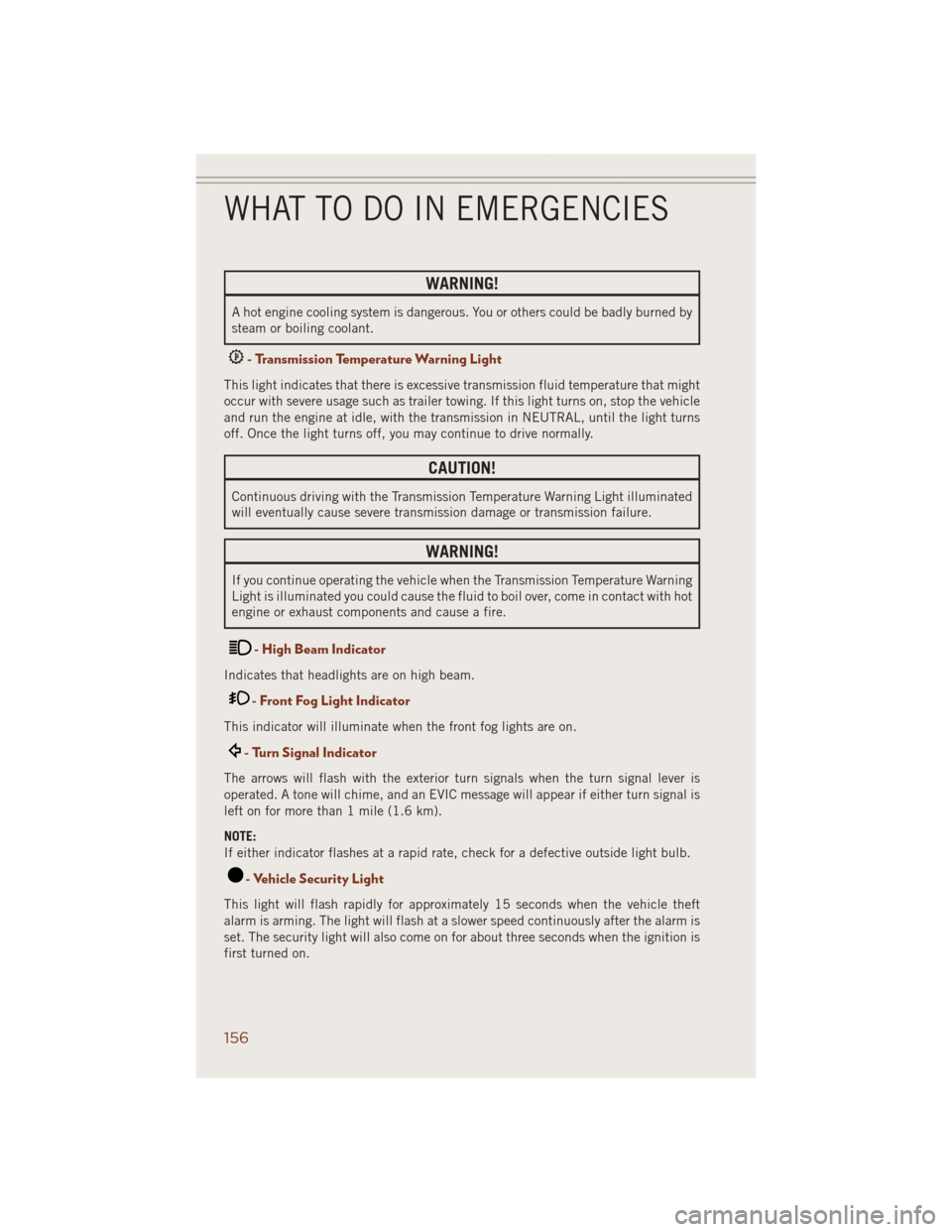
WARNING!
A hot engine cooling system is dangerous. You or others could be badly burned by
steam or boiling coolant.
- Transmission Temperature Warning Light
This light indicates that there is excessive transmission fluid temperature that might
occur with severe usage such as trailer towing. If this light turns on, stop the vehicle
and run the engine at idle, with the transmission in NEUTRAL, until the light turns
off. Once the light turns off, you may continue to drive normally.
CAUTION!
Continuous driving with the Transmission Temperature Warning Light illuminated
will eventually cause severe transmission damage or transmission failure.
WARNING!
If you continue operating the vehicle when the Transmission Temperature Warning
Light is illuminated you could cause the fluid to boil over, come in contact with hot
engine or exhaust components and cause a fire.
- High Beam Indicator
Indicates that headlights are on high beam.
- Front Fog Light Indicator
This indicator will illuminate when the front fog lights are on.
- Turn Signal Indicator
The arrows will flash with the exterior turn signals when the turn signal lever is
operated. A tone will chime, and an EVIC message will appear if either turn signal is
left on for more than 1 mile (1.6 km).
NOTE:
If either indicator flashes at a rapid rate, check for a defective outside light bulb.
- Vehicle Security Light
This light will flash rapidly for approximately 15 seconds when the vehicle theft
alarm is arming. The light will flash at a slower speed continuously after the alarm is
set. The security light will also come on for about three seconds when the ignition is
first turned on.
WHAT TO DO IN EMERGENCIES
156
Page 160 of 220
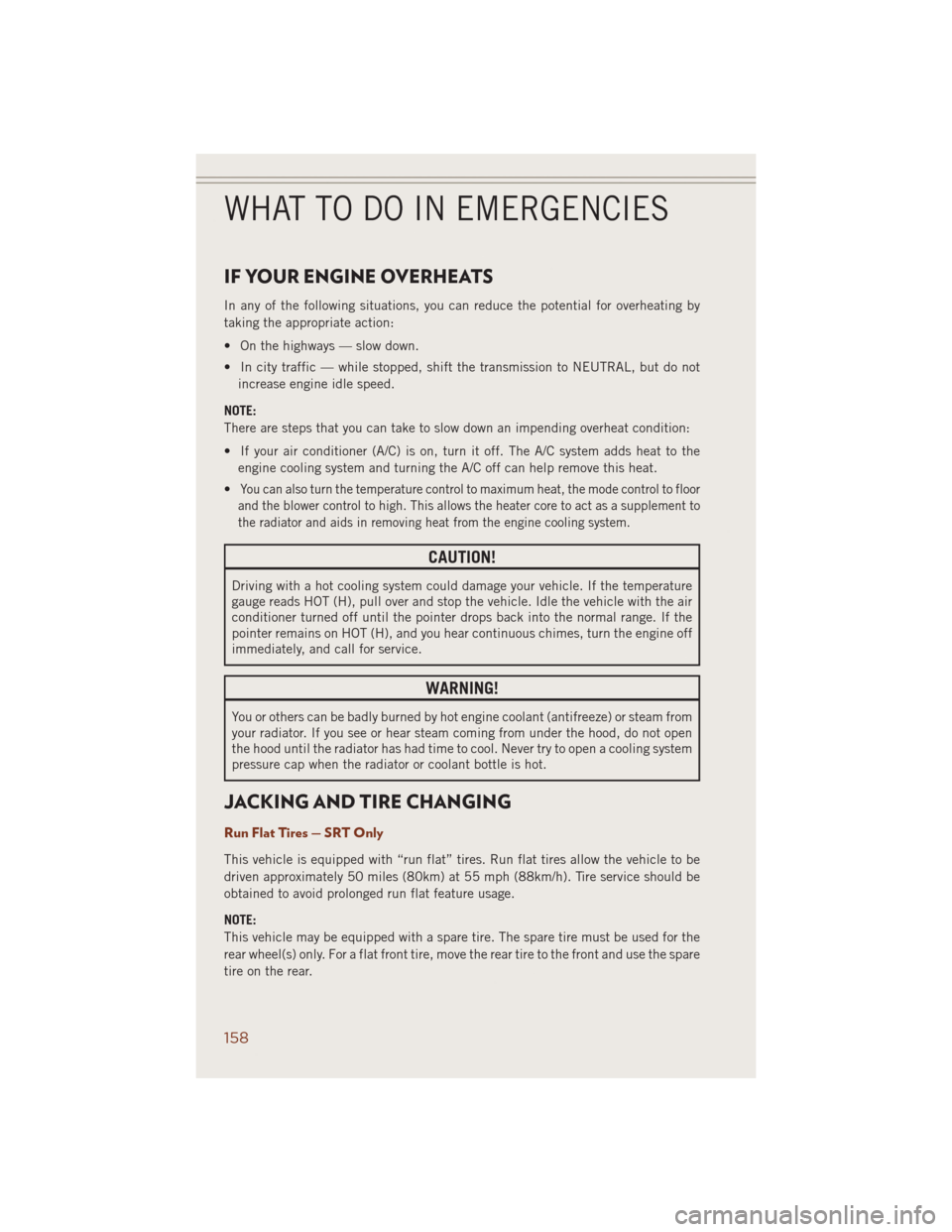
IF YOUR ENGINE OVERHEATS
In any of the following situations, you can reduce the potential for overheating by
taking the appropriate action:
• On the highways — slow down.
• In city traffic — while stopped, shift the transmission to NEUTRAL, but do not
increase engine idle speed.
NOTE:
There are steps that you can take to slow down an impending overheat condition:
• If your air conditioner (A/C) is on, turn it off. The A/C system adds heat to the
engine cooling system and turning the A/C off can help remove this heat.
•
You can also turn the temperature control to maximum heat, the mode control to floor
and the blower control to high. This allows the heater core to act as a supplement to
the radiator and aids in removing heat from the engine cooling system.
CAUTION!
Driving with a hot cooling system could damage your vehicle. If the temperature
gauge reads HOT (H), pull over and stop the vehicle. Idle the vehicle with the air
conditioner turned off until the pointer drops back into the normal range. If the
pointer remains on HOT (H), and you hear continuous chimes, turn the engine off
immediately, and call for service.
WARNING!
You or others can be badly burned by hot engine coolant (antifreeze) or steam from
your radiator. If you see or hear steam coming from under the hood, do not open
the hood until the radiator has had time to cool. Never try to open a cooling system
pressure cap when the radiator or coolant bottle is hot.
JACKING AND TIRE CHANGING
Run Flat Tires — SRT Only
This vehicle is equipped with “run flat” tires. Run flat tires allow the vehicle to be
driven approximately 50 miles (80km) at 55 mph (88km/h). Tire service should be
obtained to avoid prolonged run flat feature usage.
NOTE:
This vehicle may be equipped with a spare tire. The spare tire must be used for the
rear wheel(s) only. For a flat front tire, move the rear tire to the front and use the spare
tire on the rear.
WHAT TO DO IN EMERGENCIES
158
Page 181 of 220
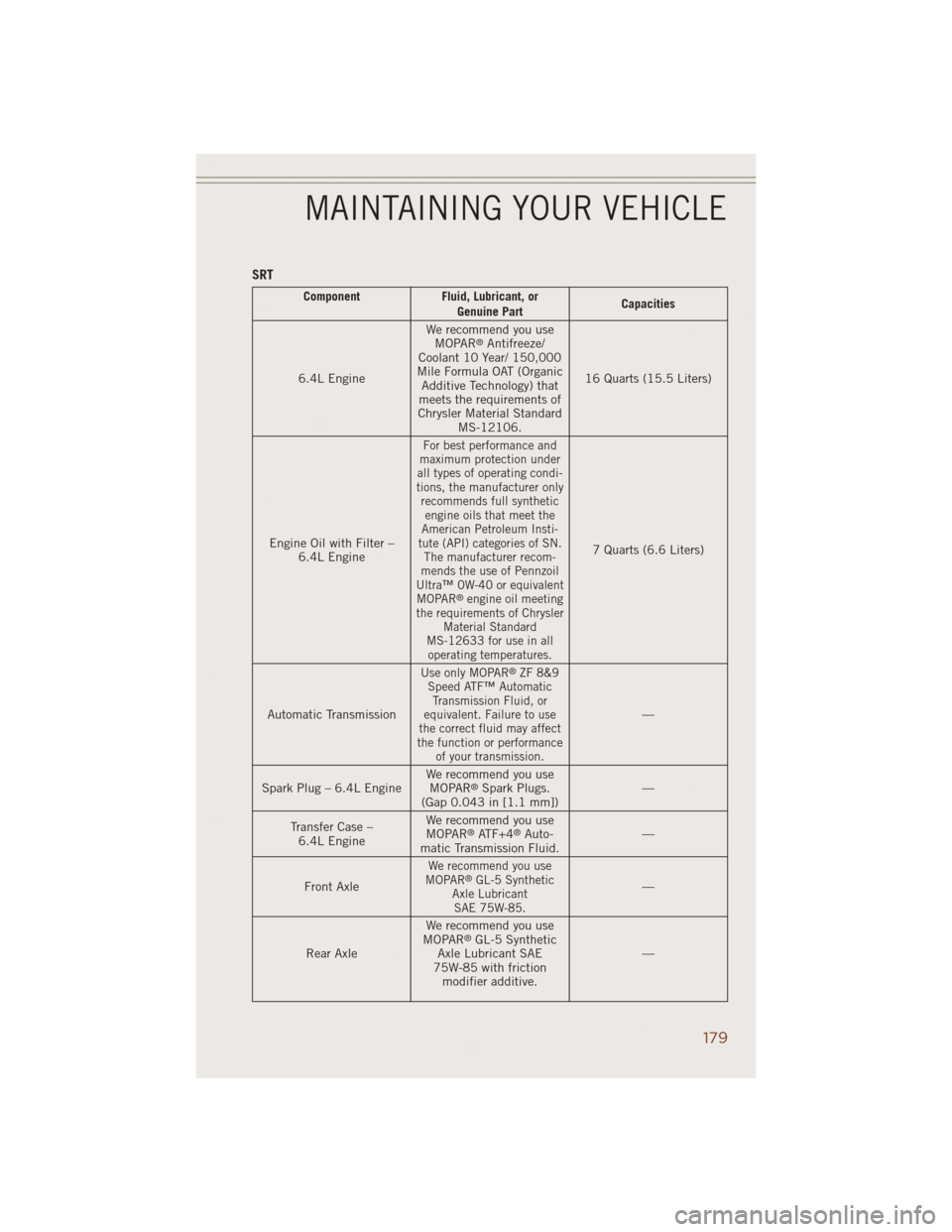
SRT
Component Fluid, Lubricant, or
Genuine PartCapacities
6.4L EngineWe recommend you use
MOPAR
®Antifreeze/
Coolant 10 Year/ 150,000
Mile Formula OAT (Organic
Additive Technology) that
meets the requirements of
Chrysler Material Standard
MS-12106.16 Quarts (15.5 Liters)
Engine Oil with Filter –
6.4L Engine
For best performance and
maximum protection under
all types of operating condi-
tions, the manufacturer only
recommends full synthetic
engine oils that meet the
American Petroleum Insti-
tute (API) categories of SN.
The manufacturer recom-
mends the use of Pennzoil
Ultra™ 0W-40 or equivalent
MOPAR
®engine oil meeting
the requirements of Chrysler
Material Standard
MS-12633 for use in all
operating temperatures.
7 Quarts (6.6 Liters)
Automatic Transmission
Use only MOPAR®ZF 8&9
Speed ATF™ Automatic
Transmission Fluid, or
equivalent. Failure to use
the correct fluid may affect
the function or performance
of your transmission.
—
Spark Plug – 6.4L EngineWe recommend you use
MOPAR
®Spark Plugs.
(Gap 0.043 in [1.1 mm])—
Transfer Case –
6.4L EngineWe recommend you use
MOPAR
®ATF+4®Auto-
matic Transmission Fluid.—
Front Axle
We recommend you use
MOPAR®GL-5 Synthetic
Axle Lubricant
SAE 75W-85.—
Rear AxleWe recommend you use
MOPAR
®GL-5 Synthetic
Axle Lubricant SAE
75W-85 with friction
modifier additive.—
MAINTAINING YOUR VEHICLE
179
Page 186 of 220
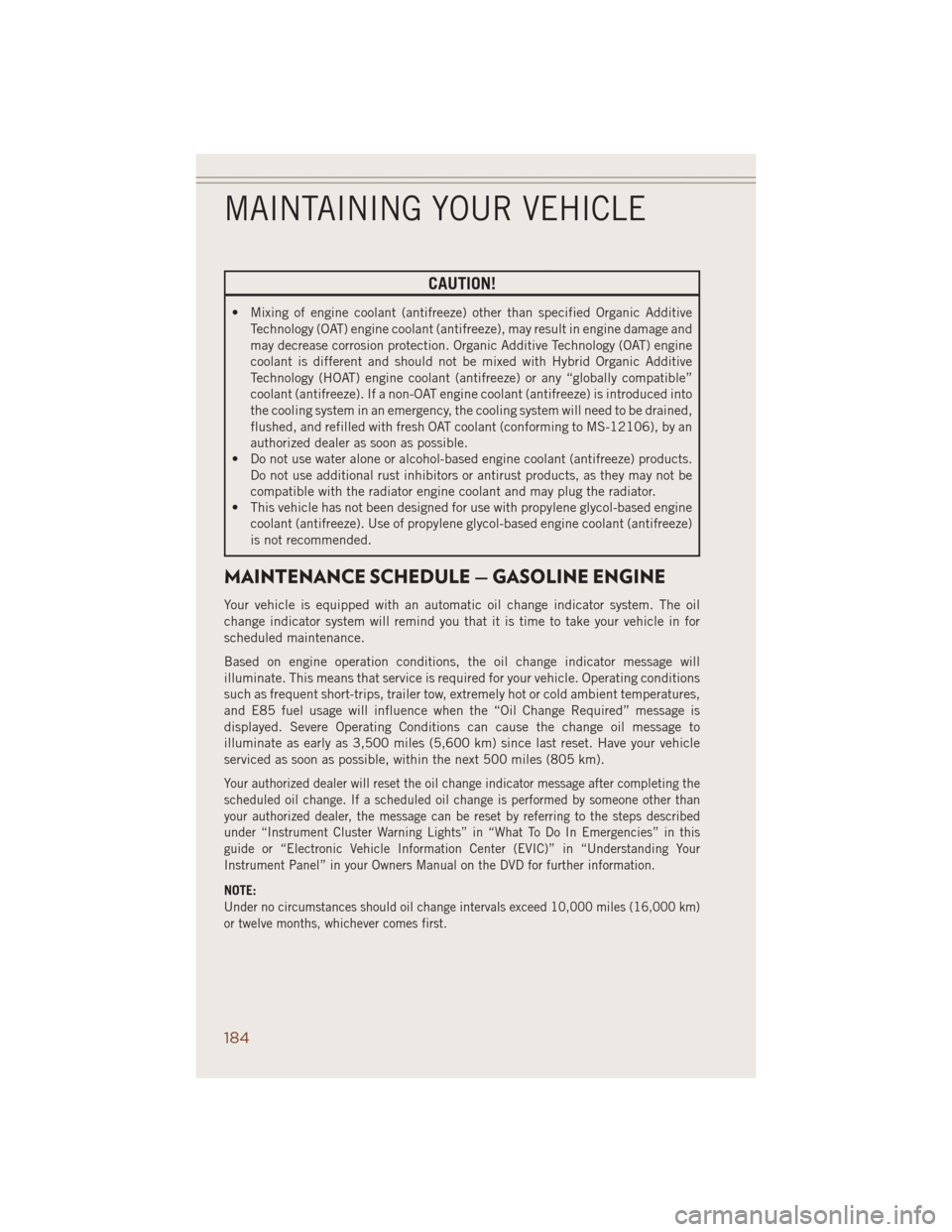
CAUTION!
• Mixing of engine coolant (antifreeze) other than specified Organic Additive
Technology (OAT) engine coolant (antifreeze), may result in engine damage and
may decrease corrosion protection. Organic Additive Technology (OAT) engine
coolant is different and should not be mixed with Hybrid Organic Additive
Technology (HOAT) engine coolant (antifreeze) or any “globally compatible”
coolant (antifreeze). If a non-OAT engine coolant (antifreeze) is introduced into
the cooling system in an emergency, the cooling system will need to be drained,
flushed, and refilled with fresh OAT coolant (conforming to MS-12106), by an
authorized dealer as soon as possible.
• Do not use water alone or alcohol-based engine coolant (antifreeze) products.
Do not use additional rust inhibitors or antirust products, as they may not be
compatible with the radiator engine coolant and may plug the radiator.
• This vehicle has not been designed for use with propylene glycol-based engine
coolant (antifreeze). Use of propylene glycol-based engine coolant (antifreeze)
is not recommended.
MAINTENANCE SCHEDULE — GASOLINE ENGINE
Your vehicle is equipped with an automatic oil change indicator system. The oil
change indicator system will remind you that it is time to take your vehicle in for
scheduled maintenance.
Based on engine operation conditions, the oil change indicator message will
illuminate. This means that service is required for your vehicle. Operating conditions
such as frequent short-trips, trailer tow, extremely hot or cold ambient temperatures,
and E85 fuel usage will influence when the “Oil Change Required” message is
displayed. Severe Operating Conditions can cause the change oil message to
illuminate as early as 3,500 miles (5,600 km) since last reset. Have your vehicle
serviced as soon as possible, within the next 500 miles (805 km).
Your authorized dealer will reset the oil change indicator message after completing the
scheduled oil change. If a scheduled oil change is performed by someone other than
your authorized dealer, the message can be reset by referring to the steps described
under “Instrument Cluster Warning Lights” in “What To Do In Emergencies” in this
guide or “Electronic Vehicle Information Center (EVIC)” in “Understanding Your
Instrument Panel” in your Owners Manual on the DVD for further information.
NOTE:
Under no circumstances should oil change intervals exceed 10,000 miles (16,000 km)
or twelve months, whichever comes first.
MAINTAINING YOUR VEHICLE
184
Page 213 of 220
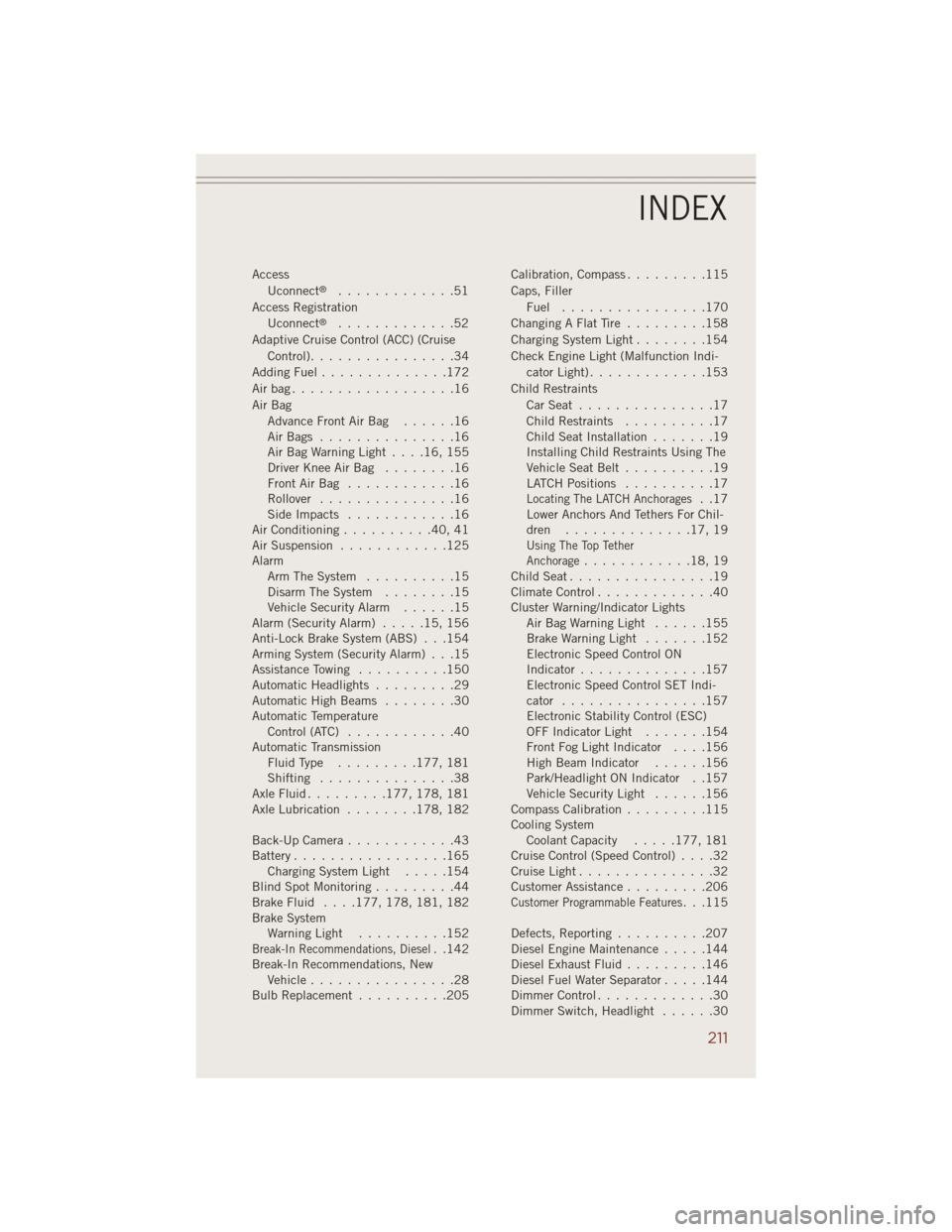
Access
Uconnect®.............51
Access Registration
Uconnect
®.............52
Adaptive Cruise Control (ACC) (Cruise
Control)................34
Adding Fuel..............172
Airbag..................16
Air Bag
AdvanceFrontAirBag ......16
AirBags ...............16
AirBagWarningLight....16,155
Driver Knee Air Bag........16
FrontAirBag ............16
Rollover...............16
SideImpacts ............16
Air Conditioning..........40,41
Air Suspension............125
Alarm
Arm The System..........15
Disarm The System........15
Vehicle Security Alarm......15
Alarm (Security Alarm).....15,156
Anti-Lock Brake System (ABS) . . .154
Arming System (Security Alarm) . . .15
Assistance Towing..........150
Automatic Headlights.........29
Automatic High Beams........30
Automatic Temperature
Control (ATC)............40
Automatic Transmission
FluidType .........177, 181
Shifting...............38
AxleFluid.........177, 178, 181
Axle Lubrication........178, 182
Back-Up Camera............43
Battery.................165
Charging System Light.....154
Blind Spot Monitoring.........44
Brake Fluid....177, 178, 181, 182
Brake System
WarningLight ..........152
Break-In Recommendations, Diesel. .142
Break-In Recommendations, New
Vehicle................28
BulbReplacement ..........205Calibration, Compass.........115
Caps, Filler
Fuel ................170
ChangingAFlatTire .........158
Charging System Light........154
Check Engine Light (Malfunction Indi-
cator Light).............153
Child Restraints
CarSeat ...............17
Child Restraints..........17
Child Seat Installation.......19
Installing Child Restraints Using The
Vehicle Seat Belt..........19
LATCH Positions..........17
Locating The LATCH Anchorages..17
Lower Anchors And Tethers For Chil-
dren ..............17,19
Using The Top Tether
Anchorage............18,19
ChildSeat................19
Climate Control.............40
Cluster Warning/Indicator Lights
AirBagWarningLight ......155
Brake Warning Light.......152
Electronic Speed Control ON
Indicator..............157
Electronic Speed Control SET Indi-
cator................157
Electronic Stability Control (ESC)
OFF Indicator Light.......154
Front Fog Light Indicator....156
High Beam Indicator......156
Park/Headlight ON Indicator . .157
Vehicle Security Light......156
Compass Calibration.........115
Cooling System
Coolant Capacity.....177, 181
Cruise Control (Speed Control)....32
CruiseLight...............32
Customer Assistance.........206
Customer Programmable Features...115
Defects, Reporting..........207
Diesel Engine Maintenance.....144
Diesel Exhaust Fluid.........146
Diesel Fuel Water Separator.....144
DimmerControl.............30
Dimmer Switch, Headlight......30
INDEX
211